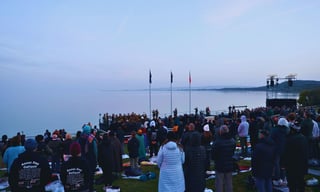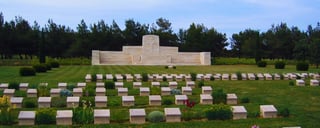Top Things To Do In Gallipoli
Gallipoli is a historic and significant destination in Turkey, known for its World War I battlefields and memorials. Here are some things to do in Gallipoli:

Here are Some Things to do in Gallipoli:
Visit The Gallipoli Peninsula Historical National Park:

This park encompasses the battlefields and memorials of the Gallipoli Campaign. Explore the trenches, walk through the war cemeteries, and visit the numerous monuments and memorials dedicated to the soldiers who fought and lost their lives during the battle. Visiting the Gallipoli Peninsula Historical National Park is a significant and poignant experience, offering a chance to explore the historical sites and pay tribute to the soldiers who fought in the Gallipoli Campaign during World War I. Here are some things to do in the park:
- ANZAC Cove: Begin your visit at ANZAC Cove, the famous landing site of the Australian and New Zealand Army Corps (ANZAC) troops. Take a moment to reflect on the events that unfolded here and visit the memorial dedicated to the ANZAC soldiers.
- Lone Pine Cemetery and Memorial: Pay your respects at the Lone Pine Cemetery, the final resting place for many Australian and Turkish soldiers. Explore the beautifully maintained grounds and visit the memorial that commemorates the Australian soldiers who lost their lives in the Battle of Lone Pine.
- Chunuk Bair New Zealand Memorial: Visit the Chunuk Bair Memorial, which honors the New Zealand soldiers who fought in the Gallipoli Campaign. Enjoy the scenic views from this elevated location and learn about the New Zealand contribution to the battle.
- Turkish 57th Infantry Regiment Memorial: Explore the Turkish 57th Infantry Regiment Memorial, which is dedicated to the Turkish soldiers who defended their homeland during the Gallipoli Campaign. Gain insight into the Turkish perspective and their sacrifices during the conflict.
- Kabatepe Museum: Visit the Kabatepe Museum, located near the park entrance, to learn more about the Gallipoli Campaign and its historical context. The museum displays a collection of artifacts, photographs, and documents that provide valuable insights into the events that took place.
- Battlefield Tours: Consider joining a guided battlefield tour to gain a deeper understanding of the Gallipoli Campaign. Knowledgeable guides will provide historical context, share stories of the soldiers, and take you to key sites across the peninsula.
- Beaches and Scenic Walks: Take leisurely walks along the beaches of the Gallipoli Peninsula, enjoying the serene coastal scenery. Visit Brighton Beach, Ari Burnu, and other significant beachfront areas that were part of the battlefield.
- Attend Commemorative Services: If you have the opportunity, attend a commemorative service held at one of the memorial sites. These services often take place on significant dates, such as ANZAC Day (April 25th) or Turkish Martyrs' Day (March 18th), and offer a chance to honor the fallen soldiers and pay tribute to their memory.
- Visiting the Gallipoli Peninsula Historical National Park is a solemn and educational experience that allows you to understand the impact of war and appreciate the historical significance of this important battlefield. It is a place of remembrance, where visitors can reflect on the sacrifices made by soldiers from various nations and gain a deeper appreciation for the enduring spirit of courage and resilience.
Attend The Dawn Service at Anzac Cove:

If you have the opportunity, attending the Dawn Service on Anzac Day (April 25th) at Anzac Cove is a deeply moving experience. It commemorates the soldiers who fought in the Gallipoli Campaign and pays tribute to their sacrifice.Attending the Dawn Service at Anzac Cove is a deeply meaningful and emotional experience for those visiting the Gallipoli Peninsula. The Dawn Service is held annually on April 25th, ANZAC Day, to commemorate the soldiers who fought and lost their lives during the Gallipoli Campaign of World War I. Here is what you can expect when attending the Dawn Service:
- Arrival and Preparation: The Dawn Service typically begins in the early hours of the morning, with visitors arriving well before dawn. It is advisable to arrive early to secure a good viewing spot and to allow time for security checks and registration if required.
- Candlelight Vigil: As darkness blankets the area, participants light candles and hold a candlelight vigil, creating a solemn and reflective atmosphere. The flickering candles symbolize remembrance and respect for the fallen soldiers.
- Commemorative Program: The Dawn Service follows a structured program that includes readings, speeches, prayers, hymns, and the playing of bugle calls such as the Last Post and Reveille. These elements contribute to the solemnity and commemorative nature of the event.
- Reflective Silence: At the exact time of the Gallipoli landings, a moment of silence is observed to honor the soldiers who made the ultimate sacrifice. This silence allows attendees to reflect on the significance of the events that took place on that day.
- Wreath-Laying Ceremony: During the service, representatives from various nations, military organizations, and community groups lay wreaths or floral tributes at designated areas as a mark of respect and remembrance.
- Dawn Breaks and Reveille: As the first light of dawn emerges on the horizon, the bugle call of Reveille is played, symbolizing the awakening of a new day. This poignant moment signifies hope, resilience, and the enduring legacy of those who served.
- Reflection and Remembrance: Following the formal program, attendees have the opportunity to spend time in quiet reflection, visit memorial sites, and pay their respects to the fallen soldiers. Many people search for the names of their ancestors inscribed on memorial walls or headstones.
- Attending the Dawn Service at Anzac Cove is a deeply moving and respectful way to honor the soldiers who fought and died during the Gallipoli Campaign. It allows visitors to connect with the history, sacrifice, and shared sense of remembrance associated with this significant event. It is important to approach the service with reverence, observe the protocols and instructions given, and remember that it is a solemn occasion that pays tribute to those who served.
Explore The Battlefields:
Take a guided tour or self-guided tour to explore the historic battlefields of Gallipoli. Walk in the footsteps of the soldiers, learn about the military strategies, and gain insights into the challenges faced during the campaign. Significant sites to visit include Lone Pine, Chunuk Bair, and the Nek.Exploring the battlefields of Gallipoli is a poignant and historically significant experience. Here are some key points to consider when visiting the battlefields:
- Anzac Cove: Start your exploration at Anzac Cove, the landing site of the Australian and New Zealand Army Corps (ANZAC) on April 25, 1915. Take a moment to reflect on the courage and sacrifice of the soldiers who landed here.
- Lone Pine Cemetery and Memorial: Visit Lone Pine Cemetery, the resting place of many Australian and Turkish soldiers. The Lone Pine Memorial stands as a tribute to the soldiers who fought and lost their lives during the campaign.
- Chunuk Bair: Journey to Chunuk Bair, a strategic high point that witnessed intense fighting. Explore the Chunuk Bair Memorial and enjoy the panoramic views of the surrounding area.
- Helles Memorial and Beaches: Visit the Helles Memorial, dedicated to the British and French soldiers who fought in the southern part of the peninsula. Take time to walk along the nearby beaches, such as V Beach and W Beach, and imagine the events that unfolded there.
- Kabatepe Museum: Begin your visit to Gallipoli at the Kabatepe Museum, which provides a comprehensive overview of the campaign through its exhibits and artifacts. It offers valuable historical context for your exploration of the battlefields.
- Trenches and Tunnels: As you walk through the battlefields, you'll encounter preserved trenches and tunnels that were used by soldiers during the campaign. These remnants provide a glimpse into the challenging conditions and tactics employed during the conflict.
- Turkish Memorials and Cemeteries: Take a moment to visit the Turkish memorials and cemeteries that honor the Turkish soldiers who fought in the campaign. Pay your respects and acknowledge the shared sacrifice of all those involved.
- While exploring the battlefields, it's important to approach the sites with respect and sensitivity. Reflect on the historical significance, pay tribute to the lives lost, and gain a deeper understanding of the events that unfolded during the Gallipoli Campaign.
Visit The Anzac Cove Cemetery:

Pay your respects at the Anzac Cove Cemetery, where many soldiers from Australia and New Zealand are buried. Take a moment to reflect and remember the lives lost during the campaign. Visiting the Anzac Cove Cemetery in Gallipoli is a solemn and important experience that allows you to pay tribute to the fallen soldiers who fought during the Gallipoli Campaign. Here's what you can expect when visiting the cemetery:
- Location and Significance: The Anzac Cove Cemetery is situated near the site where the Australian and New Zealand troops landed on April 25, 1915, as part of the Gallipoli Campaign during World War I. It holds great historical significance as the resting place for many Anzac soldiers.
- Commemorative Headstones: The cemetery is marked by rows of white headstones, each representing the final resting place of a soldier. The headstones are maintained with care and feature inscriptions that include the soldier's name, rank, and regiment.
- Memorials and Monuments: Within the cemetery, you will find various memorials and monuments dedicated to different groups of soldiers. These may include specific national memorials or plaques honoring individual units or regiments.
- Reflective Atmosphere: The cemetery offers a serene and reflective atmosphere, providing visitors with an opportunity to pay their respects, reflect on the sacrifices made by the soldiers, and remember the impact of war. It's a place for quiet contemplation and remembrance.
- Visitor Services: The Anzac Cove Cemetery is maintained by the Commonwealth War Graves Commission, which ensures the proper care and upkeep of the site. Visitors can find information boards and maps to navigate the cemetery and learn more about its historical significance.
- Poppy Crosses and Personal Tributes: Many visitors leave poppy crosses or personal tributes on the headstones as a way of honoring and remembering the soldiers. You may also find visitors engaging in quiet reflection or participating in commemorative ceremonies during specific times of the year, such as Anzac Day.
- Visiting the Anzac Cove Cemetery provides a poignant reminder of the sacrifices made by the soldiers during the Gallipoli Campaign. It offers an opportunity to pay your respects, reflect on the human cost of war, and gain a deeper understanding of the historical significance of the Gallipoli Peninsula.
Explore The Gallipoli Museum:

Located in the town of Eceabat, the Gallipoli Museum provides in-depth information about the Gallipoli Campaign, showcasing artifacts, photographs, and personal stories of the soldiers. It offers a comprehensive understanding of the historical events that took place.I apologize for the confusion, but there is no specific museum called the "Gallipoli Museum" in the Gallipoli region. However, there are several museums and memorial sites in the area that provide insights into the history and significance of the Gallipoli Campaign. Here are a few notable sites you can visit:
- Kabatepe Museum: Located near the entrance of the Gallipoli Peninsula Historical National Park, the Kabatepe Museum showcases a comprehensive collection of artifacts, photographs, and documents related to the Gallipoli Campaign. It offers a detailed account of the military strategies, the experiences of soldiers, and the historical context of the battle.
- The Turkish 57th Infantry Regiment Memorial Museum: This museum, also known as the Çanakkale Martyrs' Memorial Museum, is situated near the Turkish memorial sites on the Gallipoli Peninsula. It exhibits a collection of photographs, military equipment, and personal belongings of Turkish soldiers who fought during the Gallipoli Campaign.
- Anzac Museum at the Australian War Memorial: The Australian War Memorial in Canberra, Australia, houses the Anzac Museum, which focuses on the history and stories of the Australian and New Zealand forces during World War I, including the Gallipoli Campaign. The museum offers a comprehensive display of artifacts, photographs, and interactive exhibits.
- New Zealand Gallipoli Association Museum: Located in Wellington, New Zealand, this museum provides a dedicated space to explore the experiences and stories of New Zealand soldiers during the Gallipoli Campaign. It features artifacts, personal accounts, and multimedia presentations that offer insights into the New Zealand perspective of the battle.
- These museums provide a deeper understanding of the Gallipoli Campaign, its impact on the involved nations, and the sacrifices made by the soldiers. They offer a chance to learn about the historical context, view artifacts, and gain a greater appreciation for the significance of the battle.
Take a Boat Tour:

Experience the coastline of Gallipoli from the water with a boat tour. Enjoy the scenic views of the peninsula, visit small islands, and take in the natural beauty of the area.Taking a boat tour is a popular activity in the Gallipoli region, as it allows you to explore the coastal areas and witness the beautiful landscapes. While there are various types of boat tours available, including private charters and group tours, here are some common options:
- Gallipoli Peninsula Boat Tour: This tour takes you along the coastline of the Gallipoli Peninsula, allowing you to see the historic sites from the perspective of the sea. You can enjoy views of the battlefields, cemeteries, and memorials while learning about the history of the Gallipoli Campaign from knowledgeable guides.
- Bosphorus Boat Tour: If you're interested in combining your visit to Gallipoli with a boat tour in Istanbul, you can take a Bosphorus cruise. The Bosphorus Strait connects the Black Sea to the Sea of Marmara and offers breathtaking views of Istanbul's iconic landmarks, such as the Hagia Sophia, Topkapi Palace, and the Bosphorus Bridge.
- Aegean Sea Boat Tour: For a more leisurely experience, you can opt for a boat tour along the Aegean Sea. This tour allows you to relax on deck, soak up the sun, and enjoy the turquoise waters and picturesque coastal views. Some boat tours may include swimming stops at secluded bays or provide opportunities for snorkeling and diving.
- Fishing Tours: If you enjoy fishing, you can join a fishing tour in the Gallipoli region. These tours provide an opportunity to experience the traditional fishing methods and techniques of the local fishermen. You can try your hand at fishing and enjoy the peacefulness of the sea.
- Before booking a boat tour, make sure to research reputable tour operators, check their itineraries, and read reviews from previous visitors. It's also a good idea to inquire about the duration of the tour, the facilities available on board, and any additional activities or services included.
Visit the Kabatepe War Museum:

Located near the entrance of the Gallipoli Peninsula Historical National Park, this museum displays a collection of military artifacts, including weapons, uniforms, photographs, and documents related to the Gallipoli Campaign.The Kabatepe War Museum is an important historical site located on the Gallipoli Peninsula in Turkey. Here's some information about the museum and what you can expect during your visit:
- Museum Exhibits: The Kabatepe War Museum houses a collection of artifacts, photographs, documents, and personal belongings related to the Gallipoli Campaign of World War I. The exhibits provide insights into the military strategies, equipment, and conditions experienced by soldiers during the battle.
- Historical Context: The museum offers a comprehensive overview of the Gallipoli Campaign, including the reasons behind the conflict, the involvement of various nations, and the significant events that unfolded during the battle. It helps visitors understand the historical significance of the Gallipoli Peninsula.
- Galleries: The museum features multiple galleries that showcase different aspects of the war. Some galleries focus on specific battles, while others provide information about the soldiers' daily lives, medical facilities, and the role of the Ottoman Empire. The exhibits are accompanied by informative signage and multimedia presentations.
- Outdoor Display: Outside the museum, you'll find a display of military equipment, artillery, trenches, and replica bunkers. This outdoor area allows visitors to explore and visualize the battlefield environment.
- Commemorative Areas: The museum includes several areas dedicated to the commemoration of fallen soldiers. These spaces provide a solemn atmosphere for reflection and paying respects to those who lost their lives during the Gallipoli Campaign.
- Guided Tours: Guided tours are available at the Kabatepe War Museum, offering valuable insights and detailed explanations about the exhibits and the historical context. Professional guides provide commentary in various languages, ensuring a comprehensive understanding of the museum's content.
- Visitor Facilities: The museum provides visitor facilities, including a gift shop where you can purchase books, souvenirs, and memorabilia related to the Gallipoli Campaign. There are also on-site cafes or restaurants where you can grab a snack or meal.
- When planning your visit to the Kabatepe War Museum, it's advisable to check the opening hours and any entry requirements in advance. Additionally, consider combining your museum visit with exploring other nearby historical sites and cemeteries that are significant to the Gallipoli Campaign.
Attend Commemorative Ceremonies:
Throughout the year, various commemorative ceremonies and events are held to honor the soldiers and keep the memory of the Gallipoli Campaign alive. Check the schedule and participate in these ceremonies to pay your respects and learn more about the history and significance of the battle.Attending commemorative ceremonies is a meaningful way to pay tribute to the soldiers who lost their lives during the Gallipoli Campaign. Here's some information about these ceremonies:
- Anzac Day Dawn Service: Anzac Day, observed on April 25th each year, is a significant commemorative event held at Anzac Cove on the Gallipoli Peninsula. The Dawn Service begins in the early morning hours, with attendees gathering to honor the soldiers who fought and remember their sacrifices. The service typically includes readings, hymns, speeches, and a moment of silence.
- International Memorial Service: The International Memorial Service is another significant commemorative event that takes place at various memorial sites across the Gallipoli Peninsula. This service involves representatives from different countries coming together to remember and honor the fallen soldiers from their respective nations. It provides a chance for people of diverse backgrounds to unite in remembrance.
- Wreath-Laying Ceremonies: Throughout the year, wreath-laying ceremonies are held at various memorials and cemeteries in the Gallipoli region. These ceremonies involve laying wreaths or floral tributes at the memorials to show respect and remembrance. People have the opportunity to participate in these ceremonies by laying their own wreaths or flowers in honor of specific individuals or groups.
- National Day of Remembrance: The Turkish National Day of Remembrance is observed on March 18th each year to commemorate the Ottoman victory during the Gallipoli Campaign. On this day, official ceremonies and events are held in Turkey, including wreath-laying ceremonies and memorial services. Attending these events can provide insight into the Turkish perspective on the historical significance of Gallipoli.
- Visiting Gallipoli offers a unique opportunity to understand and reflect upon the sacrifices made during World War I. It is a place of historical importance, where visitors can learn about the human cost of war and the resilience of the soldiers involved.
